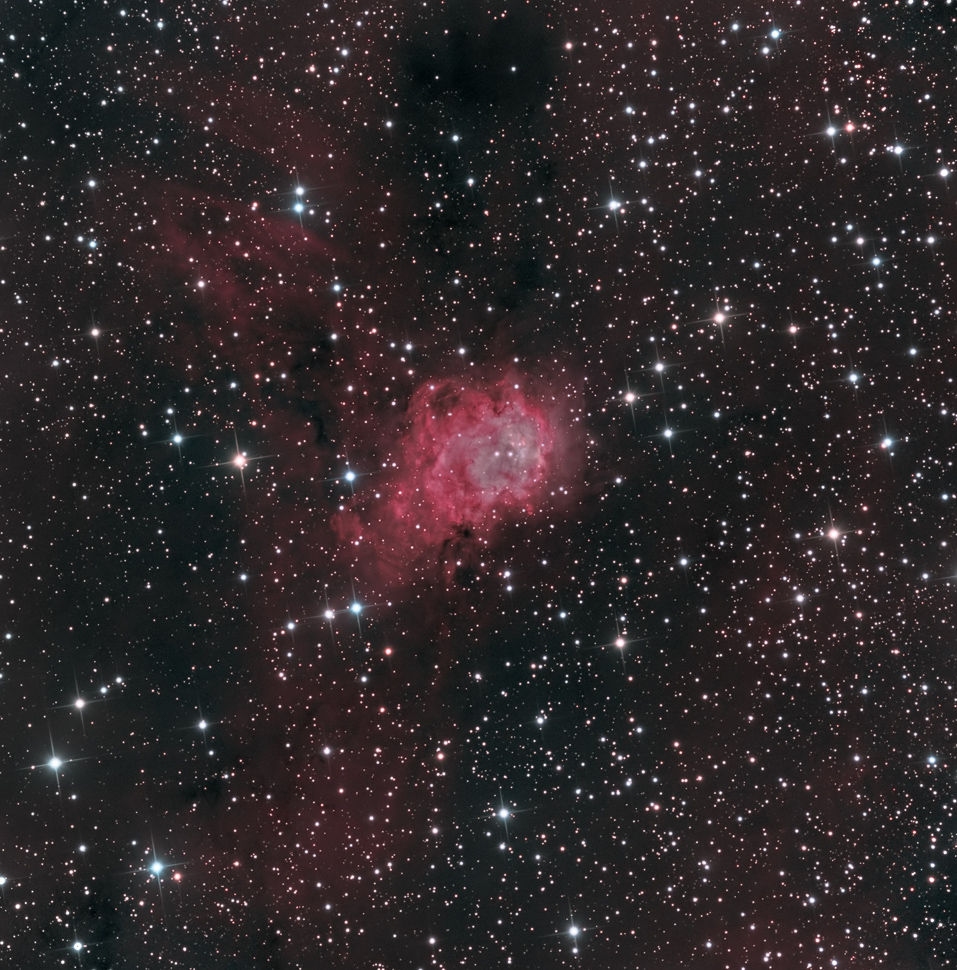HOME
NGC7538
NGC7538
Emission Nebula in Cepheus
Click here for higher-resolution versions: 40% (1530x1550) 65%
(2487x2520) 100% (3826x3876)  Click on image to cycle through a true-color version, a version in the colors of the Hubble palette, and the grayscale (mostly pure Ha) version
Click on image to cycle through a true-color version, a version in the colors of the Hubble palette, and the grayscale (mostly pure Ha) version
NGC7538: This is an emission nebula (meaning that its light is generated by its gasses emitting light, rather than reflecting light) in Cepheus, quite near the Bubble Nebula,
of which I also have an image taken many years ago when I first started imaging. The gas forming the nebula is ionized by the bright, hot stars
toward the center of the nebula, which generates light in various wavelengths.
NGC7538 is home to the largest "protostar" yet discovered, an odd ovoid with the mass of 500 suns, with its long axis spanning about 35 light-years and its short axis about 25 light-years.
Astronomers study stellar nurseries such as NGC 7538 to better learn how stars come into being.
The nebula is about 9,100 light years from Earth, making it roughly 24 light years long (if my trigonometry is correct).
I have presented this in three different formats (accessed by repeatedly clicking on the photo, waiting for each to download the first time):
(i) A true-color version, with the color created by imaging through red, green and blue filters (with the luminance layer being a blend of luminance-filtered data and
Ha-filtered data; a significant amount of ionized hydrogen emissions (Ha) and ionized sulfur emissions (SII) were blended into the red channel, and doubly-ionized oxygen emissions (OIII) data were
blended into the green and blue channels, in varying percentages);
(ii) A version in the Hubble palette (a lot of the Hubble photos, including and especially the famous "Pillars of Creation," are made with this set of filters, since
it's a useful set for scientists to see what's actually happening), which shows SII emissions as red, Ha emissions as green, and OIII as blue. I cheated a bit, in three ways: (i) I used a modified
copy of the luminance layer from the true-color image as a luminance layer for this image, to give it better definition; (ii) I copied most of the stars from the "true-color" version into the Hubble
palette version, because the Hubble palette makes most stars a vivid magenta (which I find distracting), and (iii) because the Ha in this object is so dominant, the Hubble palette version would be
almost all green if left alone; so I emphasized the SII emissions (shows up as the yellowed parts) and the OIII emissions (shows up as blue), and
(iii) A grayscale version, predominantly consisting of Ha emissions, with some wide-band emissions (luminance-filtered data) included.
The "true color" version is meant to show approximately the colors of the object; the Hubble palette is just because Hubble does it that way, and it's interesting to add the (relatively sparse)
sulfure emissions; and grayscale just because I love the smoky, smooth nature of an Ha image (which shows up very well in the larger versions of the images).
This is the second time I have imaged this target; the first time was when I was just starting with this hobby, with fairly elemental equipment (at least by comparison), and from my own yard. If you
want to see if there has been any improvement during the intervening 18 years, click here.
Technical Information:
Ha:OIII:SII:L:R:G:B: 480:510:360:420:225:270:320 (a total of over 43 hours of light-frame exposure time); luminance, red and green exposures were all 15-minute exposures;
blue were all 20-minute exposures; Ha, SII and OIII were all 30-minute exposures.
Equipment: RC Optical Systems 14.5 inch Ritchey-Chretien carbon fiber truss telescope, with ion-milled optics and RCOS field flattener, at about f/9, and an SBIG STX-16803 camera with
internal filter wheel (SBIG filter set), guided by an SBIG AO-X, all riding on a Bisque Paramount ME German Equatorial Mount.
Image Acquisition/Camera Control: Maxim DL, controlled with ACP Expert/Scheduler, working in concert with TheSky X.
Processing: All images calibrated (darks, bias and sky flats), cosmetically-corrected, aligned, combined and cropped in Pixinsight. Color combine in Pixinsight.
Some finish work (background neutralization, color calibration, deconvolution, lessening the dynamic range and noise reduction) done in Pixinsight; some cleanup finish work was done in Photoshop CC.
Location: Data acquired remotely from Deep Sky West Remote Observatory, Rowe, New Mexico, USA.
Date: Images taken on many nights in June, July, August and September 2019. Image posted October 7, 2019.
Date: Image scale of full-resolution image: 0.56 arcseconds per pixel.
CCD Chip temperature: -25C
Copyright 2019 Mark de Regt
